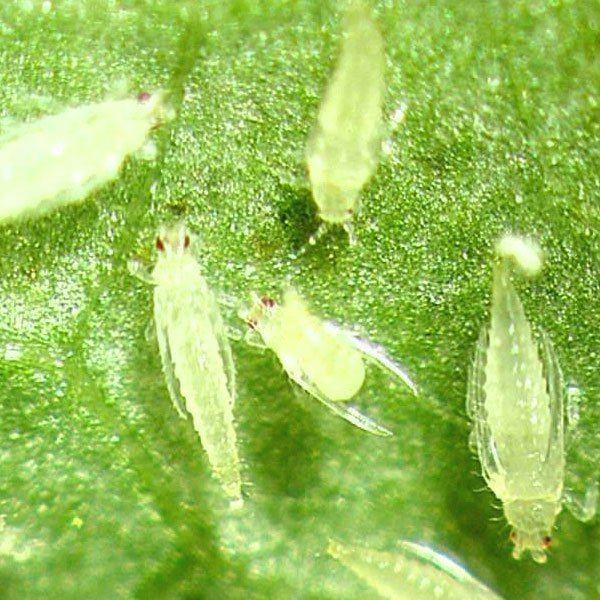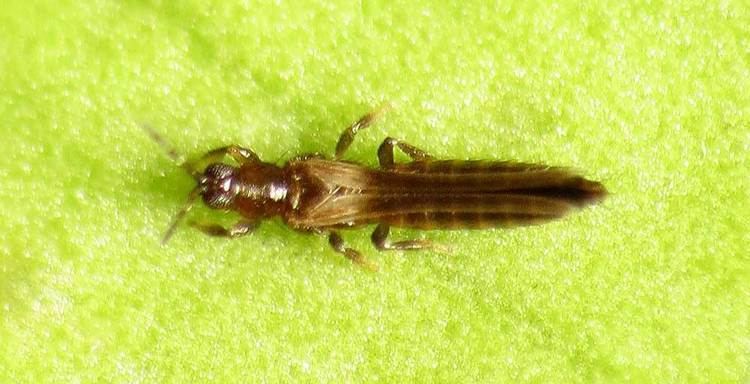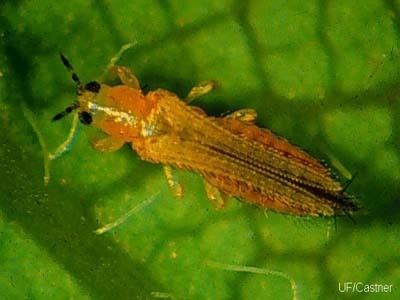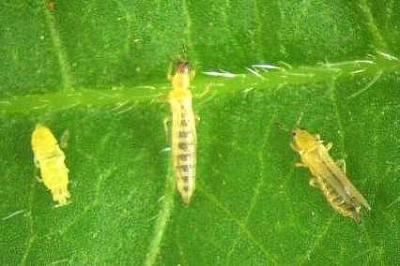Scientific name Thysanoptera Rank Order Subclass Pterygota | Superorder Exopterygota Higher classification Exopterygota | |
 | ||
Similar Insect, Aphid, Whitefly, Western flower thri, Thripidae | ||
The life cycle of thrips
Thrips (order Thysanoptera) are minute (1 mm long or less), slender insects with fringed wings and unique asymmetrical mouthparts. Different thrips species feed on a large variety of plants and animals, puncturing them and sucking up the contents. Approximately 6,000 species have been described. They fly only weakly, and their feathery wings are unsuitable for conventional flight; instead, thrips exploit an unusual mechanism, clap and fling, to create lift using an unsteady circulation pattern with transient vortices near the wings.
Contents
- The life cycle of thrips
- How to kill thrips pests in your garden
- Etymology
- Morphology
- Evolution
- Phylogeny
- Taxonomy
- Feeding
- Pollination
- Damage to plants
- Social behaviour
- Flight
- Lifecycle
- As pests
- Management
- References

Many thrips species are pests of commercially important crops. A few species serve as vectors for over 20 viruses that cause plant disease, especially the Tospoviruses. Some species of thrips are beneficial as they feed on other insects or mites. In the right conditions, such as in greenhouses, many species can exponentially increase in population size and form large swarms because of a lack of natural predators, making them an irritation to humans.

How to kill thrips pests in your garden
Etymology

The generic and English name thrips is a direct transliteration of the ancient Greek θρίψ, thrips, meaning "woodworm". Like some other animal names such as sheep, deer, and moose, the word thrips is both the singular and plural forms, so there may be many thrips or a single thrips. Other common names for thrips include thunderflies, thunderbugs, storm flies, thunderblights, storm bugs, corn flies, corn lice, freckle bugs, and physopods. The name of the order Thysanoptera is constructed from the ancient Greek words θύσανος, thysanos, "tassel or fringe", and πτερόν, pteron, "wing", for the insects' fringed wings.
Morphology

Thrips are small hemimetabolic insects with a distinctive cigar-shaped bauplan. They are elongated with transversely constricted bodies. They range in size from 0.5 to 14 mm (0.02 to 0.55 in) in length for the larger predatory thrips, but most thrips are about 1 mm in length. Flight-capable thrips have two similar, strap-like pairs of wings with a fringe of bristles. Their legs usually end in two tarsal segments with a bladder-like structure known as an "arolium" at the pretarsus. This structure can be everted by means of hemolymph pressure, enabling the insect to walk on vertical surfaces.
Thrips have asymmetrical mouthparts unique to the group. Unlike the Hemiptera (true bugs), the right mandible of thrips is reduced and vestigial – and in some species completely absent. The left mandible is larger, forming a narrow stylet used to pierce the cell wall of tissues. Some species inject digestive enzymes as the maxillary stylets and hypopharynx are inserted into the opening to drain cellular fluids. This process leaves a distinctive silvery or bronze scarring on the surfaces of the stems or leaves where the thrips have fed.
Thysanoptera is divided into two suborders, Terebrantia and Tubulifera; these can be distinguished by morphological, behavioral, and developmental characteristics. Tubulifera consists of a single family, Phlaeothripidae; members can be identified by their characteristic tube-shaped apical abdominal segment, egg-laying atop the surface of leaves, and three "pupal" stages. Females of the eight families of the Terebrantia all possess the eponymous saw-like ovipositor on the anteapical abdominal segment, lay eggs singly within plant tissue, and have two "pupal" stages.
Evolution
The Thysanoptera were first described in 1744 as the genus Physapus by the Swedish entomologist Charles De Geer, and then renamed Thrips by Linnaeus in 1758. In 1836 the Irish entomologist Alexander Henry Haliday promoted the genus to the rank of order, renaming them Thysanoptera. There are currently over six thousand species of thrips recognized, grouped into 777 extant and sixty fossil genera.
The earliest fossils of thrips date back to the Permian (Permothrips longipennis Martynov, 1935). By the Early Cretaceous, true thrips became much more abundant. The extant family Merothripidae most resemble these ancestral Thysanoptera, and are probably basal to the order.
Phylogeny
The external relationships of the Thysanoptera shown in the cladogram are based on analysis of the phylogeny of the Paraneoptera by Hu Li and colleagues in 2015, using mitochondrial DNA sequences. The lice (Liposcelididae + Phthiraptera) are the sister group to the Thysanoptera. English names are given in parentheses where possible.
The phylogeny of thrips families has been little studied. A preliminary analysis in 2013 of 37 species using 3 genes, as well as a phylogeny based on ribosomal DNA and three proteins in 2012, supports the monophyly of the two suborders, Tubulifera and Terebrantia. In Terebrantia, Melanothripidae may be sister to all other families, but other relationships remain unclear. In Tubulifera, the Phlaeothripidae and its subfamily Idolothripinae are monophyletic. The two largest thrips subfamilies, Phlaeothripinae and Thripinae, are paraphyletic and need further work to determine their structure. The internal relationships from these analyses are shown in the cladogram.
Taxonomy
The following families are currently (2013) recognized:
Feeding
Thrips are believed to have descended from a fungus-feeding ancestor during the Mesozoic, and many groups still feed upon and inadvertently redistribute fungal spores. These live among leaf litter or on dead wood and are important members of the ecosystem, their diet often being supplemented with pollen. Other species are primitively eusocial and form plant galls and still others are predatory on mites and other thrips.
Most research has focused on thrips species that feed on economically significant crops. Some species are predatory, but most of them feed on pollen and the chloroplasts harvested from the outer layer of plant epidermal and mesophyll cells. They prefer tender parts of the plant, such as buds, flowers and new leaves.
Pollination
Some flower-feeding thrips pollinate the flowers they are feeding on, and some authors suspect that they may have been among the first insects to evolve a relationship pollinating their host plants. Scirtothrips dorsalis carries pollen of commercially important chili peppers. Thrips setipennis is the sole pollinator of Wilkiea huegeliana, a small, unisexual annually flowering tree or shrub in the rainforests of eastern Australia. T. setipennis serves as an obligate pollinator for other Australian rainforest plant species, including Myrsine howittiana and M. variabilis. Thrips are likewise the primary pollinators of heathers in the family Ericaceae.
Damage to plants
The most obvious contribution that thrips make to their ecosystem is the damage they can cause during feeding. This impact may fall across a broad selection of prey items, as there is considerable breadth in host affinity across the order, and even within a species, varying degrees of fidelity to a described host remain. Family Thripidae is particularly notorious for members with broad host ranges, and the majority of pest thrips come from this family. For example, Thrips tabaci damages crops of onions, potatoes, tobacco, and cotton.
Social behaviour
While poorly documented, chemical communication is believed to be important to the group. Anal secretions are produced in the hindgut, and released along the posterior setae as predator deterrents.
Many thrips form galls on plants when feeding or laying their eggs. Some of the gall-forming Phlaeothripidae, such as genera Kladothrips and Oncothrips, form eusocial groups similar to ant colonies, with reproductive queens and nonreproductive soldier castes.
Flight
Most insects create lift by the stiff-winged mechanism of insect flight with steady state aerodynamics; this creates a leading edge vortex continuously as the wing moves. The feathery wings of thrips, however, generate lift by clap and fling, a mechanism discovered by the Danish zoologist Torkel Weis-Fogh in 1973. In the clap part of the cycle, the wings approach each other over the insect's back, creating a circulation of air which sets up vortices and generates useful forces on the wings. The leading edges of the wings touch, and the wings rotates around their leading edges, bringing them together in the "clap". The wings close, expelling air from between them, giving more useful thrust. The wings rotate around their trailing edges to begin the "fling", creating useful forces. The leading edges move apart, making air rush in between them and setting up new vortices, generating more force on the wings. The trailing edge vortices however cancel each other out with opposing flows. Weis-Fogh suggested that this cancellation might help the circulation of air to grow more rapidly, by shutting down the Wagner effect which would otherwise counteract the growth of the circulation.
Lifecycle
Thrips lay extremely small eggs, about 0.2 mm long. Females of the suborder Terebrantia cut slits in plant tissue with their ovipositor, and insert their eggs, one per slit. Females of the suborder Tubulifera lay their eggs singly or in small groups on the outside surfaces of plants.
Thrips are hemimetabolous, metamorphosing gradually to the adult form. The first two instars, called larvae or nymphs, are like small wingless adults without genitalia; these feed on plant tissue. In the Terebrantia, the third and fourth instars, and in the Tubulifera also a fifth instar, are non-feeding resting stages similar to pupae: in these stages, the body's organs are reshaped, and wing-buds and genitalia are formed. The adult stage can be reached in around 8–15 days; adults can live for around 45 days.
Thrips are haplodiploid with haploid males (from unfertilised eggs, as in Hymenoptera) and diploid females capable of parthenogenesis (reproducing without fertilisation), many species using arrhenotoky, a few using thelytoky. The sex-determining bacterial endosymbiont Wolbachia sometimes helps to define the reproductive mode. Several normally bisexual species have become established in the United States with only females present.
As pests
Many thrips are pests of commercial crops due to the damage caused by feeding on developing flowers or vegetables, causing discoloration, deformities, and reduced marketability of the crop. Some thrips serve as vectors for plant diseases, such as tospoviruses. Over 20 plant-infecting viruses are known to be transmitted by thrips, but perversely, less than a dozen of the described species are known to vector tospoviruses. These enveloped viruses are considered among some of the most damaging of emerging plant pathogens around the world, with those vector species having an outsized impact on human agriculture. Virus members include the tomato spotted wilt virus and the impatiens necrotic spot viruses. The western flower thrips, Frankliniella occidentalis, has spread until it now has a worldwide distribution, and is the primary vector of plant diseases caused by tospoviruses. Their small size and predisposition towards enclosed places makes them difficult to detect by phytosanitary inspection, while their eggs, laid inside plant tissue, are well-protected from pesticide sprays. When coupled with the increasing globalization of trade and the growth of greenhouse agriculture, thrips, unsurprisingly, are among the fastest growing group of invasive species in the world. Examples include F. occidentalis, Thrips simplex, and Thrips palmi.
Flower-feeding thrips are routinely attracted to bright floral colors (including white, blue, and especially yellow), and will land and attempt to feed. It is not uncommon for some species (e.g., Frankliniella tritici and Limothrips cerealium) to "bite" humans under such circumstances. Although no species feed on blood and no known animal disease is transmitted by thrips, some skin irritation has been described.
Management
Thrips develop resistance to insecticides easily and there is constant research on how to control them. This makes thrips ideal as models for testing the effectiveness of new pesticides and methods.
Due to their small sizes and high rates of reproduction, thrips are difficult to control using classical biological control. Suitable predators must be small and slender enough to penetrate the crevices where thrips hide while feeding, and they must also prey extensively on eggs and larvae to be effective. Only two families of parasitoid Hymenoptera parasitize eggs and larvae, the Eulophidae and the Trichogrammatidae. Other biocontrol agents of adults and larvae include anthocorid bugs of genus Orius, and phytoseiid mites. Biological insecticides such as the fungi Beauveria bassiana and Verticillium lecanii can kill thrips at all life-cycle stages. Insecticidal soap spray is effective against thrips. It is commercially available or can be made of certain types of household soap. Scientists in Japan report that significant reductions in larva and adult melon thrips occur when plants are illuminated with red light.
